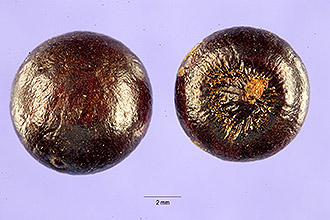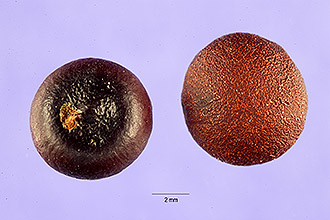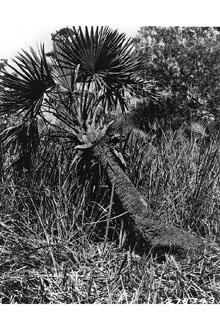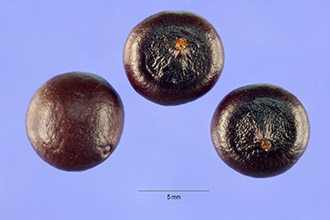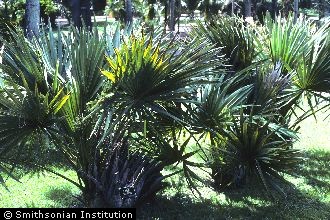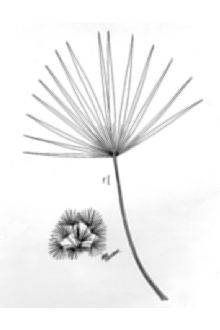Sabal deeringiana Small
Scientific Name: Sabal deeringiana Small
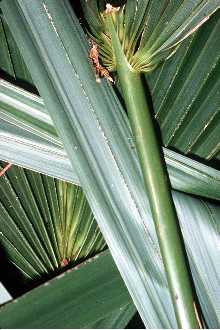
| General Information | |
|---|---|
| Usda Symbol | SADE9 |
| Group | Monocot |
| Life Cycle | Perennial |
| Growth Habits | ShrubTree, |
| Native Locations | SADE9 |
Plant Guide
Alternate Names
Bluestem, scrub palmetto, bush palmetto, , Use soil moisture sensors to measure the soil moisture of Sabal deeringiana Small.
Uses
Ethnobotanic: The Houma used juice crushed from the small roots as an eye medicine to relieve irritation. Dried roots were taken for high blood pressure. A tea from the dried roots was taken for kidney ailments and as a stimulant for “swimming in the head.” The fresh roots were baked and served as “palmetto bread.” The small fruits, sometimes called “famine food” were also eaten. The Seminoles, Houma, Choctaw, and other Native American tribes used the leaves of dwarf palmetto much in the same way that they used the leaves of the related tree, cabbage palmetto (Sabal palmetto). The fan-shaped leaves were used to thatch homes. Immature blades from the leaves were prepared by sun-bleaching and then braided into thin strips for use as lashings or sewn together to make baskets and other useful articles. Leaves were used to make fans that were carried during certain dances. Coiled-grass baskets tied with palmetto were made by the Houma as late as the 1930s. These unique baskets were made only in Louisiana and Tierra del Fuego. Contemporary people use the palmetto leaves to weave baskets and make small dolls with hair of Spanish moss. Wildlife: The fruits are an important food for robins and raccoons, providing from 10% to 20% of their diet. Fish crows, mockingbirds, myrtle warblers, pileated and red-bellied woodpeckers, and gray squirrels also eat the fruits. Livestock: This plant is reported to be frequently grazed by cattle, more so than any other palm.
Status
Please consult the PLANTS Web site and your State Department of Natural Resources for this plant’s current status (e.g. threatened or endangered species, state noxious status, and wetland indicator values).
Description
General: This shrub-like palm generally reaches a height of only 0.5 to 2 m. The stem is usually not visible, being either buried or very short, although it has been reported to occasionally reach 8m tall in Louisiana and Texas. The circular, fan-like leaves are composed of 16 to 40 pale- or blue-green blades that are 15dm wide. These stiff, nearly flat blades do not have a prominent midrib. The white flower petals are 2 to 3 mm long. The small fruits (6-8mm in diameter) are glossy black in color and enclose a large seed (5-6mm). The fruits ripen in the fall. Similar species: Cabbage palmetto (Sabal palmetto) is a palm tree that can reach 20 m in height. Saw palmetto (Serenoa repens) often has a similar appearance as dwarf palmetto as it has a short or horizontal stem. It grows in the same native range but is less cold hardy. Distribution: Native to the Gulf Coast States and Florida. For current distribution, please consult the Plant Profile page for this species on the PLANTS Web site.
Adaptation
Dwarf palmetto grows along streams, in swampy or rocky hammocks and in maritime heaths along the coastal plain in the southeastern United States. It is common to freshwater wetlands and floodplain forests where it often forms dense thickets. It rarely occurs in upland woodlands. This is the hardiest of the Sabal genus as well as one of the hardiest of palms.
Establishment
Dwarf palmetto is simple to grow and can be grown in a wide variety of soils with medium drainage and fertility in both moist and fairly dry areas. It has a slow to moderate growth rate. Seeds: May be easily propagated from seed as fresh seed germinates readily. Transplant in the following year. Transplanting: It is best to transplant in June or July. Water frequently until the plant shows growth to ensure proper establishment of the root system.
Management
Established plants tend to self-sow. Fruit drupes may be removed if self-sowing is not desired. Cultivars, Improved and Selected Materials (and area of origin) These plant materials are somewhat available from commercial sources. Contact your local Natural Resources Conservation Service (formerly Soil Conservation Service) office for more information. Look in the phone book under ”United States Government.” The Natural Resources
Conservation
Service will be listed under the subheading “Department of Agriculture.”
References
Bailey, L.H. & E.Z. Bailey 1976. Hortus Third: A concise dictionary of plants cultivated in the United States and Canada. Simon and Schuster Macmillan Co., New York, New York. 1290 pp. Barbour, M.G. & W.D. Billings, Editors 2000. North American terrestrial vegetation, Second Edition. Cambridge University Press, Cambridge, UK. 708 pp. Brown, R.C. 1994. Florida’s first people: 12,000 years of human history. Pineapple Press, Inc., Sarasota, Florida. 262 pp. Chapman, A.W. 1883. Flora of the Southern United States: Flowering Plants and Ferns. Second Edition. J. Wilson and Son, Cambridge, Massachusetts. 698 pp. Flint, H.L. 1997. Landscape plants for Eastern North America. Second Edition. John Wiley and Sons, New York, New York. 842 pp. Godfrey, R.K. & J.W. Wooten 1979. Aquatic and wetland plants of Southeastern United States. Vol. 1. University of Georgia Press, Athens, Georgia. 712 pp. Halfacre, R.G. & A.R. Showcroft 1979.
Landscape
plants of the Southeast. Sparks Press, Raleigh, North Carolina. 325 pp. Kniffen, F.B., H.F. Gregory & G.A. Stokes 1994. The historic Indian Tribes of Louisiana. Louisiana State University Press, Baton Rouge, Louisiana. 324 pp. Martin, A.C., H.S. Zim & A.L. Nelson 1951. American wildlife and plants: A guide to wildlife food habits. Dover Publications, New York. 500 pp. Moerman, D.E. 1998. Native American ethnobotany. Timber Press, Portland, Oregon. 927 pp. Neill, W.T. 1956. The story of Florida’s Seminole Indians. Second Edition. Great Outdoors Publishing Co., St. Petersburg, Florida. 128 pp. Ottesen, C. 1995. The native plant primer. Harmony Books, New York, New York. 354 pp. Rogers, D.J. & C. Rogers 1991. Woody ornamentals for Deep South gardens. University of West Florida Press, Pensacola, Florida. 296 pp. Small, J.K. 1933. Manual of Southeastern flora. University of North Carolina Press, Chapel Hill, North Carolina. 1554 pp. Speck, F.G. 1941. A list of plant curatives obtained from the Houma Indians of Louisiana. Primitive Man: Quarterly Bulletin of the Catholic Anthropological Conference Vol. XIV(4): 49-75. Sturtevant, W.C. 1954. The Mikasuki Seminole: medical beliefs and practices. Doctoral Dissertation, Yale University. 538 pp. Tiner, R.W. 1993. Field guide to coastal wetland plants of the Southeastern United States. University of Massachusetts Press, Amherst, Massachusetts. 328 pp. Whitcomb, C.E. 1983. Know it and grow it, II: A guide to the identification and use of landscape plants. Lacebark Publications, Stillwater, Oklahoma. 740 pp.
Plant Traits
Growth Requirements
| Temperature, Minimum (°F) | 7 |
|---|---|
| Adapted to Coarse Textured Soils | No |
| Adapted to Fine Textured Soils | Yes |
| Adapted to Medium Textured Soils | Yes |
| Anaerobic Tolerance | High |
| CaCO3 Tolerance | None |
| Cold Stratification Required | No |
| Drought Tolerance | None |
| Fertility Requirement | Low |
| Fire Tolerance | Medium |
| Frost Free Days, Minimum | 180 |
| Hedge Tolerance | None |
| Moisture Use | High |
| pH, Maximum | 6.5 |
| pH, Minimum | 5.5 |
| Planting Density per Acre, Maxim | 100 |
| Planting Density per Acre, Minim | 50 |
| Precipitation, Maximum | 80 |
| Precipitation, Minimum | 35 |
| Root Depth, Minimum (inches) | 18 |
| Salinity Tolerance | None |
| Shade Tolerance | Tolerant |
Morphology/Physiology
| Bloat | None |
|---|---|
| Toxicity | None |
| Resprout Ability | No |
| Shape and Orientation | Erect |
| Active Growth Period | Spring and Summer |
| C:N Ratio | High |
| Coppice Potential | No |
| Fall Conspicuous | No |
| Fire Resistant | Yes |
| Flower Color | White |
| Flower Conspicuous | No |
| Foliage Color | Gray-Green |
| Foliage Porosity Summer | Dense |
| Foliage Porosity Winter | Dense |
| Foliage Texture | Coarse |
| Fruit/Seed Conspicuous | No |
| Nitrogen Fixation | None |
| Low Growing Grass | No |
| Lifespan | Moderate |
| Leaf Retention | Yes |
| Known Allelopath | No |
| Height, Mature (feet) | 9.0 |
| Height at 20 Years, Maximum (fee | 4 |
| Growth Rate | Slow |
| Growth Form | Bunch |
| Fruit/Seed Color | Black |
Reproduction
| Small Grain | No |
|---|---|
| Seedling Vigor | Low |
| Seed Spread Rate | Moderate |
| Fruit/Seed Period Begin | Fall |
| Seed per Pound | 2000 |
| Propagated by Tubers | No |
| Propagated by Sprigs | No |
| Propagated by Sod | No |
| Propagated by Seed | Yes |
| Propagated by Cuttings | No |
| Propagated by Container | Yes |
| Propagated by Bulb | No |
| Propagated by Bare Root | Yes |
| Fruit/Seed Persistence | No |
| Fruit/Seed Period End | Winter |
| Fruit/Seed Abundance | Low |
| Commercial Availability | Routinely Available |
| Bloom Period | Late Spring |
| Propagated by Corm | No |
Suitability/Use
| Veneer Product | No |
|---|---|
| Pulpwood Product | No |
| Post Product | No |
| Palatable Human | No |
| Palatable Graze Animal | Low |
| Palatable Browse Animal | Low |
| Nursery Stock Product | Yes |
| Naval Store Product | No |
| Lumber Product | No |
| Fodder Product | No |
| Christmas Tree Product | No |
| Berry/Nut/Seed Product | No |
